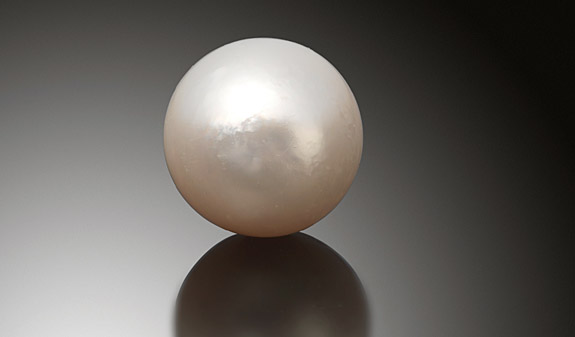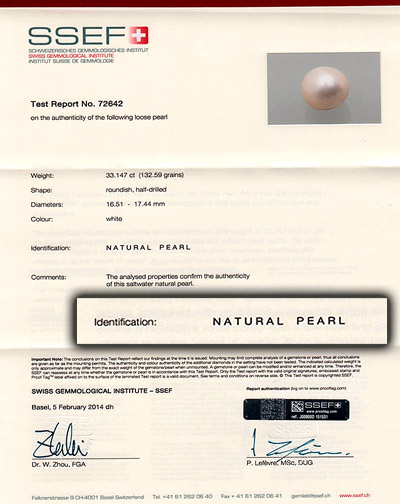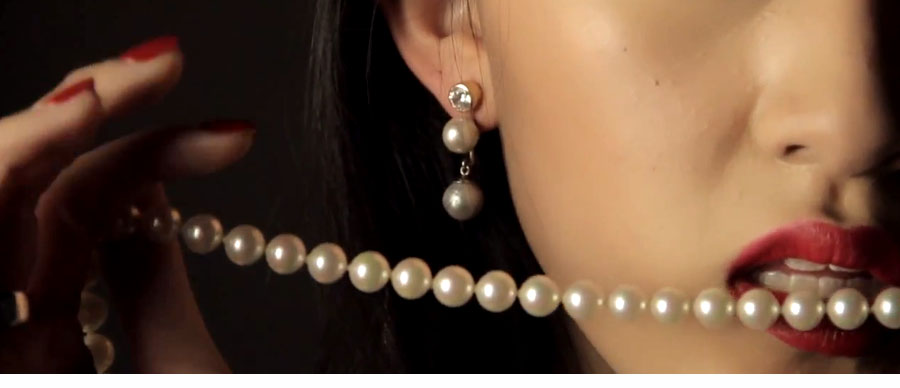April 15th, 2014
An incredibly rare 17.4mm round natural South Sea pearl could sell for $400,000 or more when it goes under the hammer at Woolley and Wallis in Salisbury, England, on May 1.

Almost as amazing as the pearl itself is the story behind it. Apparently, the woman who owned the pearl as part of a matched pair of drop earrings, didn’t realize that one of the two was a world-class natural pearl.
When she decided to put her earrings up for auction, the experts at Woolley and Wallis suspected that one of the pearls was not like the other.
“I thought there was a difference between the two because one had an outer layer of about one millimeter thick, but the other seemed to be solid,” Jonathan Edwards, head of the jewelry department at Woolley and Wallis, told the Daily Mail. “It is very difficult to tell if a pearl is cultured or natural by looking at it and you can never be 100 percent sure unless you have it X-rayed.”

Labs in London and Switzerland affirmed that the pearl was, in fact, natural. It is nearly three-quarters of an inch in diameter and took at least 10 years to develop. A grading report described the natural pearl as having an attractive white color with weak rosé and green overtones, often referred to as the "orient of pearls."
Edwards reported that the mollusk that produced the natural pearl was likely a Pinctada maxima gold-lipped oyster, which can grow up to 12 inches in diameter.
Natural pearls are organic gems, created by a mollusk totally by chance, without human intervention. When a foreign irritant gets into the mollusk’s shell, the bivalve secretes layer after of layer of nacre to protect itself. Over time, the layering of iridescent nacre produces a pearl. To find a natural pearl is a rarity. To find one 17mm in size and completely round is almost unfathomable.
Cultured pearls, by comparison, are grown under controlled conditions, where a bead is implanted in the body of the mollusk to stimulate the secretion of nacre.
Woolley and Wallis noted on its web site that the natural pearl, which weighs 33.14 carats, could be the largest to ever hit the auction block. The presale estimate was conservatively set at $200,000, but auction officials believe the final selling price could rise to $400,000 or more.
In April 2011, Christie’s in Dubai sold a 59.92-carat irregular-shape natural pearl for $254,500.

Almost as amazing as the pearl itself is the story behind it. Apparently, the woman who owned the pearl as part of a matched pair of drop earrings, didn’t realize that one of the two was a world-class natural pearl.
When she decided to put her earrings up for auction, the experts at Woolley and Wallis suspected that one of the pearls was not like the other.
“I thought there was a difference between the two because one had an outer layer of about one millimeter thick, but the other seemed to be solid,” Jonathan Edwards, head of the jewelry department at Woolley and Wallis, told the Daily Mail. “It is very difficult to tell if a pearl is cultured or natural by looking at it and you can never be 100 percent sure unless you have it X-rayed.”

Labs in London and Switzerland affirmed that the pearl was, in fact, natural. It is nearly three-quarters of an inch in diameter and took at least 10 years to develop. A grading report described the natural pearl as having an attractive white color with weak rosé and green overtones, often referred to as the "orient of pearls."
Edwards reported that the mollusk that produced the natural pearl was likely a Pinctada maxima gold-lipped oyster, which can grow up to 12 inches in diameter.
Natural pearls are organic gems, created by a mollusk totally by chance, without human intervention. When a foreign irritant gets into the mollusk’s shell, the bivalve secretes layer after of layer of nacre to protect itself. Over time, the layering of iridescent nacre produces a pearl. To find a natural pearl is a rarity. To find one 17mm in size and completely round is almost unfathomable.
Cultured pearls, by comparison, are grown under controlled conditions, where a bead is implanted in the body of the mollusk to stimulate the secretion of nacre.
Woolley and Wallis noted on its web site that the natural pearl, which weighs 33.14 carats, could be the largest to ever hit the auction block. The presale estimate was conservatively set at $200,000, but auction officials believe the final selling price could rise to $400,000 or more.
In April 2011, Christie’s in Dubai sold a 59.92-carat irregular-shape natural pearl for $254,500.


